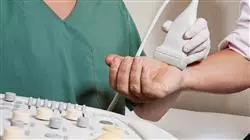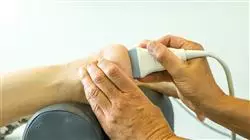University certificate
The world's largest faculty of medicine”
Introduction to the Program
Technological progress in ultrasound requires professionals to constantly update their knowledge. This Professional master’s degree provides you with the knowledge you are looking for”

The great benefits of musculoskeletal ultrasound have led to greater acceptance of this technique by medical professionals. Its usefulness in the diagnosis and treatment of injuries affecting muscles, tendons, ligaments or nerves has shifted the balance of its use against other methods and tools.
This Professional master’s degree provides medical professionals with up-to-date knowledge on Musculoskeletal Ultrasound in Rehabilitation Medicine through innovative multimedia content provided by a specialized teaching team with extensive experience in the health area.
A program taught exclusively online, where students can expand their knowledge of sonoanatomy and the different pathologies affecting the shoulder, elbow, wrist, hand, hip, knee, leg, ankle, foot and forefoot. Through a theoretical-practical approach, students will also delve deeper into each of them, aided by case studies that will bring them closer to real situations that they may encounter in their daily clinical practice.
A university program that provides students not only with exhaustive and recent knowledge in this field, but also with a flexible and convenient format, since they only need an electronic device to access the syllabus which is hosted on the virtual platform. In creating this syllabus, this academic institution has used the latest teaching technology through which the professional will develop in a more natural way thanks to the Relearning system used by TECH. Physicians, therefore, have a unique opportunity to broaden their extensive knowledge in a high-level program that is compatible with their work and personal responsibilities.
Thanks to this qualification, you will expand your knowledge in the field of diagnosis and treatment of joint injuries using ultrasound”
This Professional master’s degree in Musculoskeletal Ultrasound in Rehabilitation Medicine contains the most complete and up-to-date scientific program on the market. The most important features include:
- Practical cases presented by experts in medicine
- The graphic, schematic, and practical contents with which they are created, provide scientific and practical information on the disciplines that are essential for professional practice
- Practical exercises where the self-assessment process can be carried out to improve learning
- Special emphasis on innovative methodologies
- Theoretical lessons, questions to the expert, debate forums on controversial topics, and individual reflection assignments
- Content that is accessible from any fixed or portable device with an Internet connection
This is a university program that provides you with the most exhaustive knowledge, with the necessary scientific rigor and underthe guidance of a presitgious teaching team”
The program's teaching staff includes professionals from the sector who contribute the experience of their work to this program, as well as renowned specialists from reference societies and prestigious universities.
The multimedia content, developed with the latest educational technology, will provide the professional with situated and contextual learning, i.e., a simulated environment that will provide immersive learning programmed to train in real situations.
This program is designed around Problem-Based Learning, whereby the professional must try to solve the different professional practice situations that arise throughout the program. For this purpose, the student will be assisted by an innovative interactive video system created by renowned and experienced experts.
A university course which you can access 24 hours a day from your computer or tablet. TECH adapts to you"

It delves into the most recent advances in dynamic assessment tests for shoulder injuries"
Why study at TECH?
TECH is the world’s largest online university. With an impressive catalog of more than 14,000 university programs available in 11 languages, it is positioned as a leader in employability, with a 99% job placement rate. In addition, it relies on an enormous faculty of more than 6,000 professors of the highest international renown.

Study at the world's largest online university and guarantee your professional success. The future starts at TECH”
The world’s best online university according to FORBES
The prestigious Forbes magazine, specialized in business and finance, has highlighted TECH as “the world's best online university” This is what they have recently stated in an article in their digital edition in which they echo the success story of this institution, “thanks to the academic offer it provides, the selection of its teaching staff, and an innovative learning method aimed at educating the professionals of the future”
A revolutionary study method, a cutting-edge faculty and a practical focus: the key to TECH's success.
The most complete study plans on the university scene
TECH offers the most complete study plans on the university scene, with syllabuses that cover fundamental concepts and, at the same time, the main scientific advances in their specific scientific areas. In addition, these programs are continuously being updated to guarantee students the academic vanguard and the most in-demand professional skills. In this way, the university's qualifications provide its graduates with a significant advantage to propel their careers to success.
TECH offers the most comprehensive and intensive study plans on the current university scene.
A world-class teaching staff
TECH's teaching staff is made up of more than 6,000 professors with the highest international recognition. Professors, researchers and top executives of multinational companies, including Isaiah Covington, performance coach of the Boston Celtics; Magda Romanska, principal investigator at Harvard MetaLAB; Ignacio Wistumba, chairman of the department of translational molecular pathology at MD Anderson Cancer Center; and D.W. Pine, creative director of TIME magazine, among others.
Internationally renowned experts, specialized in different branches of Health, Technology, Communication and Business, form part of the TECH faculty.
A unique learning method
TECH is the first university to use Relearning in all its programs. It is the best online learning methodology, accredited with international teaching quality certifications, provided by prestigious educational agencies. In addition, this disruptive educational model is complemented with the “Case Method”, thereby setting up a unique online teaching strategy. Innovative teaching resources are also implemented, including detailed videos, infographics and interactive summaries.
TECH combines Relearning and the Case Method in all its university programs to guarantee excellent theoretical and practical learning, studying whenever and wherever you want.
The world's largest online university
TECH is the world’s largest online university. We are the largest educational institution, with the best and widest online educational catalog, one hundred percent online and covering the vast majority of areas of knowledge. We offer a large selection of our own degrees and accredited online undergraduate and postgraduate degrees. In total, more than 14,000 university degrees, in eleven different languages, make us the largest educational largest in the world.
TECH has the world's most extensive catalog of academic and official programs, available in more than 11 languages.
Google Premier Partner
The American technology giant has awarded TECH the Google Google Premier Partner badge. This award, which is only available to 3% of the world's companies, highlights the efficient, flexible and tailored experience that this university provides to students. The recognition as a Google Premier Partner not only accredits the maximum rigor, performance and investment in TECH's digital infrastructures, but also places this university as one of the world's leading technology companies.
Google has positioned TECH in the top 3% of the world's most important technology companies by awarding it its Google Premier Partner badge.
The official online university of the NBA
TECH is the official online university of the NBA. Thanks to our agreement with the biggest league in basketball, we offer our students exclusive university programs, as well as a wide variety of educational resources focused on the business of the league and other areas of the sports industry. Each program is made up of a uniquely designed syllabus and features exceptional guest hosts: professionals with a distinguished sports background who will offer their expertise on the most relevant topics.
TECH has been selected by the NBA, the world's top basketball league, as its official online university.
The top-rated university by its students
Students have positioned TECH as the world's top-rated university on the main review websites, with a highest rating of 4.9 out of 5, obtained from more than 1,000 reviews. These results consolidate TECH as the benchmark university institution at an international level, reflecting the excellence and positive impact of its educational model.” reflecting the excellence and positive impact of its educational model.”
TECH is the world’s top-rated university by its students.
Leaders in employability
TECH has managed to become the leading university in employability. 99% of its students obtain jobs in the academic field they have studied, within one year of completing any of the university's programs. A similar number achieve immediate career enhancement. All this thanks to a study methodology that bases its effectiveness on the acquisition of practical skills, which are absolutely necessary for professional development.
99% of TECH graduates find a job within a year of completing their studies.
Professional Master's Degree in Musculoskeletal Ultrasound in Rehabilitative Medicine
At TECH Global University, we present you our prestigious Professional Master's Degree in Musculoskeletal Ultrasound in Rehabilitative Medicine, an academic program designed for those health professionals who wish to specialize in this constantly growing area. Take advantage of this unique opportunity to expand your knowledge and excel in the field of rehabilitation medicine. In the Professional Master's Degree in Musculoskeletal Ultrasound in Rehabilitative Medicine at TECH Global University, you will have a faculty of renowned experts in musculoskeletal ultrasound. You will learn the latest techniques and applications of ultrasound in the diagnosis and monitoring of musculoskeletal injuries and pathologies. In addition, you will have the opportunity to practice with state-of-the-art ultrasound equipment, acquiring practical skills essential for your future professional practice. Upon completion of this Professional Master's Degree, you will receive a certificate recognized by TECH Global University, which will endorse your experience and knowledge in the field of musculoskeletal ultrasound in rehabilitative medicine. This program will open doors to new job opportunities and will allow you to work in clinics, hospitals, rehabilitation centers and private practices, providing quality care and helping patients in their recovery process.
A program created especially for you
Our online classes will give you the flexibility you need to study from anywhere and adapt your learning to your busy schedule. Thanks to our interactive online platform, you will have access to the Postgraduate Certificate content 24 hours a day, 7 days a week. You will be able to advance at your own pace, review lessons as many times as you need and participate in online discussions with other professionals in the field. Don't miss this opportunity to advance your career and become an expert in musculoskeletal ultrasound - enroll now in the Professional Master's Degree in Musculoskeletal Ultrasound in Rehabilitative Medicine at TECH Global University and prepare yourself for success in your field!







